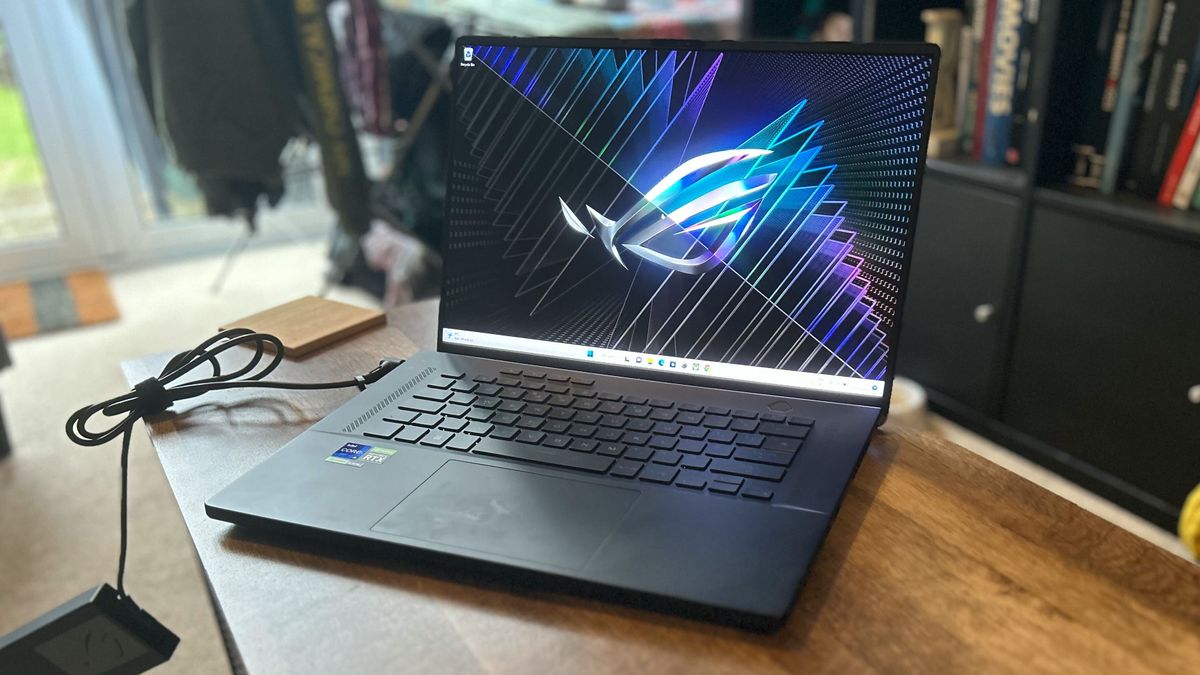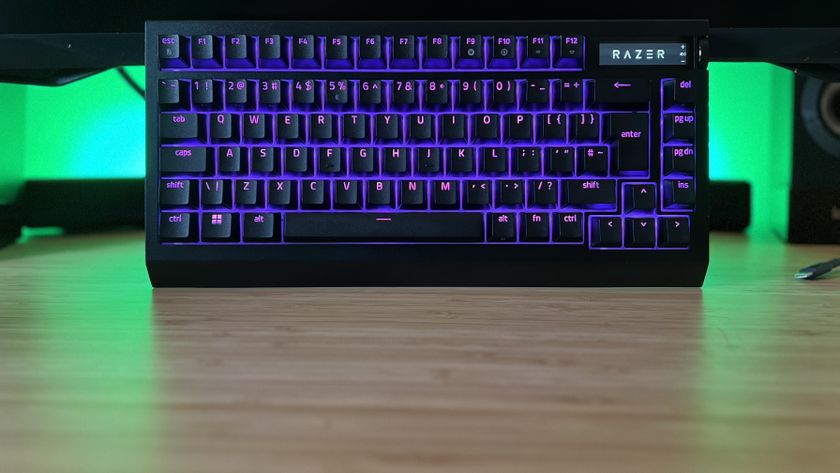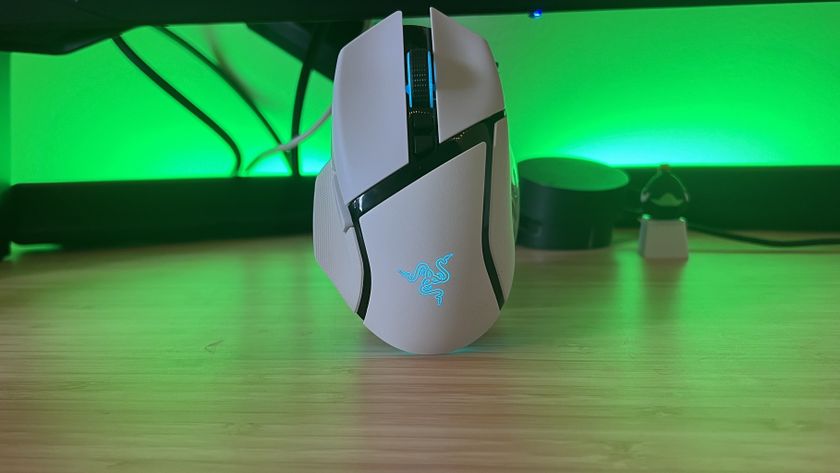12DOVE Verdict
The Asus ROG Zephyrus M16 is the first RTX 40-Series gaming laptop we've had our hands on. It's easy to see how next generation components absolutely trounce their predecessors, and this 2023 machine sings because of it. This is an industry leading device - for the moment. With Razer and Alienware poised to launch their own competitors, though, it remains to be seen whether this stunning performance can hold up to its peers.
Pros
- +
Streamlined, subtle design
- +
Next generation components offer powerful upgrade
- +
Lighter than other upcoming RTX 40-Series laptops
- +
Mini-LED display offers leading color contrast
Cons
- -
Processor is weaker than other models scheduled for release
- -
Hot spot towards the rear
- -
Fewer USB-A ports compared to competition
Why you can trust 12DOVE
The Asus ROG Zephyrus M16 is celebrated not only for its 16-inch form factor squeezed into a compact footprint, but the high-end components often packed inside. While 2023's installment makes little change to the external chassis, save for the addition of the brand's AniMe Matrix LED panel on the lids of certain configurations and the new HDR Mini LED display, this is an upgrade for the power-hungry.
This is one of the first gaming laptops to storm out the RTX 40-Series gate. That means it's under the microscope not only as the next iteration of Asus's popular do-it-all machine but also as a carrier for the next generation of Nvidia and Intel hardware. What can the M16 do with an RTX 4090 and i9-13900H at the helm? A hell of a lot.
Of course, that hardware isn't going to come cheap. The RTX 4090 spec I've been playing with for the last couple of weeks comes in at £4,099.99 here in the UK (US pricing is yet to be revealed, but that measures out at $4,950 with current exchange rates). That means the M16 is entering an arena of lightning-fast machines packed with the latest and greatest tech and engineering designs to draw the most power possible out of it.
Both Razer and Alienware have 16-inch devices on the way, both offering RTX 4090 GPU configurations and Intel's 13th generation i9 processors for around the same price point. So, should the M16 be your next heavy investment? I put this scarily expensive machine to the test to find out exactly what all this fuss is about.
The Asus ROG Zephyrus M16 will launch in mid-March 2023. This review was completed using a pre-retail unit running early drivers.
| Specs | Tested | Also Available |
|---|---|---|
| Price | £4,099.99 | Row 0 - Cell 2 |
| Display | 16-inch, 16:10 Nebula HDR QHD+ 2560 x 1600 px, miniLED, 240 Hz | QHD+ 2560 x 1600 px IPS, 165 Hz |
| Processor | Intel i9-13900H | - |
| GPU | RTX 4090 | RTX 4080 | RTX 4070 |
| RAM | 32GB DDR5 | - |
| Storage | 2TB SSD | - |
| Connectivity | WiFi 6E, Bluetooth 5.2 | - |
| Ports | 2x USB-A Gen 2, HDMI 2.1, 3.5mm, microSD card reader, 1x USB-C with Thunderbolt 4, 1x USB-C Gen2 with power delivery | - |
| Dimensions | 355 x 246.5 x 22.9mm (AniMe Matrix) | 355 x 246.5 x 22.3mm (no AniMe Matrix) |
| Weight | 2.3kg (AniMe Matrix) | 2.1kg (no AniMe Matrix) |
Design
- Sleek and solid soft-touch design with minimal branding
- Lighter than upcoming Razer and Alienware devices but thicker overall
- Durable Ergolift hinge with plenty of air vent space
Fans of previous generations will be glad to know that the Asus ROG Zephyrus M16 doesn't mess with perfection too much. There are some minor upgrades (and the addition of the AniMe Matrix LED display on the back of some models), but in general, the clean lines and subtle aesthetic of previous models are retained here.
Even with those powerful components under the hood, the 2023 M16 still manages to hold onto its compact form factor, coming in at just 2.3kg and 22.9mm in thickness. That's lighter than both the upcoming Razer Blade 16 and Alienware x16, though thicker than both of these models as well. Of course, a machine trying to pack as much punch from the RTX 4090 as it can, won't be your average slimline, backpack-friendly rig, but the Zephyrus M16 is on the right side of the line here.
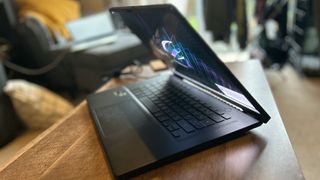
Not only that, but the body itself feels particularly solid. I felt no flex in this build, which is impressive considering that spongey architecture is something I've noticed creeping into Asus gaming laptops. Like its predecessor, the 2023 M16 features an aluminium lid with magnesium alloys for the main chassis and interior, but this time around everything feels significantly sturdier.
Many have complained of a drop in build quality around the base of previous models, which has been completed ironed out here. Yes, it feels slightly thicker than the streamlined devices I'm used to, but it still holds a slimline aesthetic and angles itself downwards from the main body which carries the illusion of a smaller device as well. On top of all that, you'll find a soft-touch material keeping everything feeling luxurious and comfortable, especially with the generous space either side of the touchpad and gentle, rounded corners.
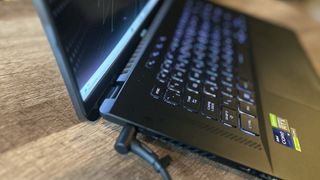
The screen itself is set back from the base with a dropped hinge running on either side of a large grill area. The Ergolift hinges are back from previous models, allowing for greater airflow around the back fans and for a full 180 degrees of movement as well. It's a slick implementation of a hinge design rapidly being adopted into more and more gaming laptops, and compliments the 16-inch, minimal-bezel display well.
Slapped on the back of certain configurations (namely the more expensive ones), you'll also find the AniMe Matrix display. This is a collection of white LEDs packed underneath small holes dotted across the main lid with a range of customizable animations, text options, stat displays, and even a virtual pet to play with. It's a gimmick, for sure, and one I never had too much time for in previous iterations. Just as I found with last year's Asus ROG Zephyrus G14, I would much rather pay less and have a thinner gaming laptop than sport a series of flashing lights that I wouldn't even get to see most of the time.
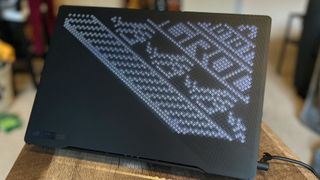
Your main control panel is made up of a standard keyboard deck, a spacious touchpad, and a series of four additional media / Asus Armoury Crate buttons. I'm a big fan of this keyboard spacing in particular - though it feels a little wider than I'm used to, I had plenty of room to scan across the deck itself. Like the rest of the body, the keycaps themselves feel silky soft to the touch - perfect for the satisfying clack of the switches underneath.
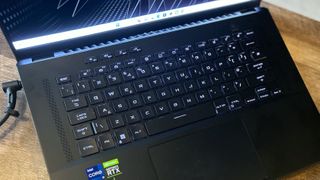
I found the typing experience to be a little softer here, compared with my own Asus TUF Dash F15, but the tactile clunk of each actuation ensured just the right amount of feedback. There's no number pad here, instead the extra base board space is taken up by two upward firing speaker grills. There's a bountiful glass trackpad here as well, offering a smooth glide and precise controls with very little flex to harder clicks.
Features
- Latest components but a slightly weaker processor vs competition
- Mini LED display won't suit competitive players but can be tweaked
- Offers plenty of connections, but only two USB-A ports
Of course, the biggest features to land with the 2023 Asus ROG Zephyrus M16 are the new Intel processor and Nvidia graphics cards. All M16 configurations come packed with the Intel Core i9-13900H, a hefty CPU for sure, but not quite the most powerful up for grabs. Of course, this processor is going to be absolutely singing for gameplay and demanding workflows (it certainly did in my testing), but it is worth noting the spec sheets for both the upcoming Razer Blade 16 and Alienware x16 boast slightly more impressive CPUs. The former will offer an i9-13950HX while the latter packs an overclockable i9-13900HK. When you're spending this much on a gaming rig, those finer performance details become all the more important.
Of course, we haven't had our hands on Razer or Alienware's entries yet which means we can't speak to the performance of these chips under the hood. On paper, though, the Asus ROG Zephyrus M16 is heading into the market at a slight power disadvantage when compared against similarly designed machines.
Onto that all-important GPU, though, and those not concerned with the RTX 4090 will be glad to know that the M16 is also available with RTX 4080 and RTX 4070 cards to nudge those costs down a little. Elsewhere, each device ships with 32GB DDR5 RAM and a 2TB SSD, as well as a new motherboard to accommodate everything.
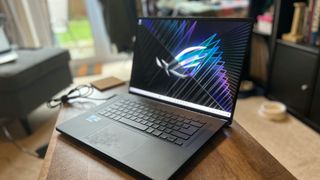
Up top, you'll find a 16-inch 16:10 screen, with the configuration I tested sporting a MiniLED panel. These displays are only starting to make their way to the world of mainstream gaming laptops, having previously been reserved for high-end TVs and more specialist rigs. Only the RTX 4090 models offer what Asus has branded its 'ROG Nebula' screen, with other variants offering IPS displays only. The new tech treats your eyes to over 1,000 dimming zones and over 1,100 nits at peak HDR brightness, covering 100% of the DCI-P3 color range.
That's because Mini-LED really means 'more LED' - loads of tiny lights working to offer more precise picture representation, with individual zones raising or lowering their light levels to offer much greater contrast on-screen. What does that mean for everyday play? Vibrant colors, rich, deep blacks, and a super bright HDR picture. Asus has other machines heading to market with its Nebula screen – namely the ROG Zephyrus G14, Strix G16, and G18 as well as the Flow series – but Razer will also take its own stab at the tech with the Blade 16 as well. Our other competitor, the Alienware x16, won't offer a MiniLED display configuration - at least at launch.
While MiniLED is going to be slower than the traditional IPS panel, and therefore potentially push eSports-focused customers away, there are ways to speed things up. Asus's Armoury Crate software allows users to disable the most power-intensive aspect of a MiniLED display - zone dimming. The picture is noticeably flatter, of course, but will become more responsive as a result. That's a nice workaround for anyone after tournament-level performance, or those after a more color-accurate display for media editing.
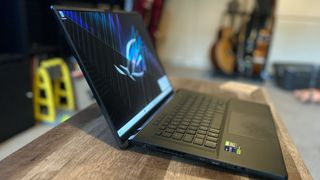
The 240Hz refresh rate is more than enough for mid-range play - yes, you can find 360Hz panels out there (and 480Hz is making its way to more gaming laptop screens this year), but I'd only recommend splashing out on these kinds of speeds if you're truly serious about your eSports chances.
Ports and connections are plentiful, though it would have been nice to pick up an additional USB-A on top of the two available here - at least to bring connectivity options in line with the three USB-As you'll find in Razer and Alienware's competing models. As it stands, you're getting two USB-A Gen 2 ports, two USB-C (one with Thunderbolt 4 and the other offering standard power delivery), HDMI 2.1, a microSD card reader, and a 3.5mm audio jack. The fingerprint sensor of previous iterations has once again been scrapped here, but you'll still find an IR camera up top.
Performance
- Silky smooth framerates of over 80fps in QHD Ultra settings
- Graphics performance averages 30% improvement over 3080 Ti machines
- Max power draw hampers true potential of RTX 4090
We run a set of industry benchmark tests on all gaming laptops we review. Time Spy and Fire Strike stress test graphical rendering, physics, ray tracing, and processing power to return a final score at the end. The higher the score, the better the result.
Maxon's Cinebench further tests the rendering power of the processor across both single and multi-core tests. Again, the higher the score the better the result. Crystal Disk Mark tests the read and write speed of an SSD. Finally, PC Mark 10 simulates a productivity setting, stress testing the processor through demanding workflows to return a final score.
Onto the good stuff. It's safe to say, the Asus ROG Zephyrus M16 can easily handle anything modern and demanding games can throw at it. QHD resolution and Ultra graphical settings? No problem, it'll spit out 80+ framerates without even blinking. The power on offer here is staggering and made booting up to scratch a Stardew Valley itch one morning feel laughable - like the Hadron Collider being used to play Pong. That RTX 4090, combined with Intel's Raptor Lake prowess, ups the game in a big way.
We've all grown a little fatigued with iterative updates over the last few years, but this is a tangible jump in performance, quality, and stability. I ran our usual benchmark tests and compared results with some of the top-performing RTX 3080 Ti gaming laptops from the previous generation, and the numbers speak for themselves.
| Benchmark | Asus ROG Zephyrus M16 | Razer Blade 15 (2022) | Razer Blade 17 (2022) | Asus ROG Strix Scar 17 SE | Alienware x15 R2 | Medion Erazer Beast X30 |
|---|---|---|---|---|---|---|
| Time Spy | 14,608 | 9,690 | 12,244 | - | 10,127 | 12,049 |
| Fire Strike | 31,877 | 20,171 | 25,484 | 29,616 | 23,241 | 26,542 |
| PC Mark 10 | 7,947 | 7,340 | 4,150 | 7,839 | 7,580 | 7,369 |
Of course, the biggest gains were seen in comparisons with 15.6-inch devices, with the Razer Blade 15 and Alienware x15 both lagging around 45% behind in Fire Strike and Time Spy benchmarks. However, even the Razer Blade 17's performance still averages a 20% deficit over that of the Asus ROG Zephyrus M16. Those 3D Mark results are the highest I've personally tested - and they should be, they're running on cutting edge tech. But it's the size of this leap that has me this excited.
Yes, CPU peformance doesn't quite reach the same heights of improvement, but there's still a solid 7,947 score here - a feat none of our previous generation machines could manage. The Asus ROG Zephyrus M16's Cinebench and Crystal Disk Mark scores were also promising, offering excellent rendering performance across both single and multi-core tests and keeping that SSD snappy as well.
Cinebench: Single core; 834 - Multi core; 17,333
Crystal Disk Mark: Read; 7,093MB/s, Write; 5,268MB/s
In a real world setting, those lofty numbers start to make more sense. Not only does everything whistle through frames, but that MiniLED display keeps visuals popping the entire time. This is one slick machine that made everything from Cyberpunk 2077 to Planet Coaster feel like a next-gen experience. The role of DLSS 3 shouldn't be discounted here, it's implementation in the RTX 4090 chip means we're pushing well above the means of that medium i9 CPU. While Cyberpunk 2077 is the only title I was able to take advantage of this supported performance with, it certainly pushed things to the next level. You'll find our full suite of in-game benchmarks in both 1080p and 1440p below.
| Benchmark Test | 1080p | 1440p |
|---|---|---|
| Shadow of the Tomb Raider | High: 169fps / Highest: 158fps | High: 148fps / Highest: 142fps |
| Total War: Three Kingdoms | High: 152fps / Ultra: 122fps | High: 110fps / Ultra: 80fps |
| Red Dead Redemption 2 | Balanced: 128fps / Highest: 117fps | Balanced: 109fps / Highest: 81fps |
| Metro Exodus | High: 131fps / Ultra: 129fps | High: 124fps / Ultra: 84fps |
| The Division 2 | High: 153fps / Ultra: 148fps | High: 139fps / Ultra: 105fps |
Not only did the voluptuous landscapes of Red Dead Redemption 2 manage to hold their frames under the stress of QHD Ultra, but the speed of The Division 2 was also maintained even in the same graphical fidelity. That's no mean feat and a testament to the impressive combination of CPU and graphics card here.
All of these benchmarks were taken in the standard Performance mode, keeping that RTX 4090 tampered with an 85W power draw. That's well below the card's 175W limit, so there's plenty more to be seen from this card in chunkier gaming laptops that can really let it sprint.
Bumping settings up to the system's built-in 'Turbo Mode' does unlock a 120W power draw, but I was surprised by the roar those fans produced when under this kind of pressure. In my own everyday play, I was more than happy with Performance Mode, which didn't require the use of a gaming headset to concentrate and still provided plenty of horsepower.
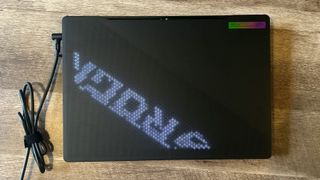
Those fans are working hard, and temperatures are manageable as a result. Asus has boosted the cooling design of the ROG Zephyrus M16, in order to keep up with the latest components, with a heatsink spread across the full back of the rig and three fans whirring away.
For the most part, this did the job. I was comfortable playing older games like Shadow of the Tomb Raider and indie games on my lap. However, turn the power on fully and I did notice a single spot of significant heat running towards the back of the main deck. That was enough to move me to a desk, though didn't noticeably impact performance.
Should you buy the 2023 Asus ROG Zephyrus M16?

There's no denying it, the Asus ROG Zephyrus M16 is a powerful gaming laptop - and the best gaming laptop we've tested yet. That's only because it's the first out the gate, though, and there will be plenty of RTX 40-Series laptops to see soon. As it stands today, the Asus ROG Zephyrus M16 is a masterclass in power and style - portable enough to sit in a backpack, but with next-generation performance to outclass the vast majority of the market. It's a long-term buy with a blinding price tag to match its gaming prowess.
If you're after an everyday machine, it should be obvious by now that the ROG Zephyrus M16 isn't going to be for you. Even the cheapest configuration is still set to hit over $3,000. 2023 versions of the Asus TUF F15 and Asus ROG Zephyrus G14 with RTX 4070 GPUs will still send you home with the latest components without breaking the bank when they launch.
However, if you are jumping in with a big purchase for the 40-Series, the M16 is certainly well worth your consideration. That Mini LED display has competition from Razer, but all we can say without seeing the opposition is that it truly outshines anything we've had our hands on before. If Asus's prices fall in line with that of the Razer Blade 16 (slated to hit $4,299.99 for a like-for-like configuration), there's going to be some difficult decisions. On paper, the Razer Blade 16 sports a better spec - a boosted i9-13950H processor and an additional USB-A port, alongside an ever so slightly slimmer design. However, the M16 avoids the constriction of a super skinny build, and may be able to draw better performance because of it.
When it comes to the Alienware conundrum, your decision is a little more clear-cut. You're getting beefier guts under the hood by waiting for the x16, but - based on spec alone - the displays simply won't match up. Dell's installment doesn't offer that Mini LED screen, so if premium HDR and contrast handling sound like a deal-breaker, you'll be set with Asus. If, however, you're looking to pump as much power into that RTX 4090 card as possible, the i9-13900HK processor under the hood of the x16 will be far better suited. It's worth noting, though, that we still don't know the price of a like-for-like configuration from Alienware.
| Specs | Asus ROG Zephyrus M16 | Razer Blade 16 | Alienware x16 |
|---|---|---|---|
| Price | £4,099.99 ($ Unannounced) | $4,299.99 | Unnanounced |
| Display | 16-inch, 16:10 Nebula HDR QHD+ 2560 x 1600 px, miniLED, 240 Hz | 16" UHD+, 16:10 (3840 x 2400 WQUXGA) Mini-LED | 16-inch QHD+ 2560 x 1600, 240Hz |
| Processor | Intel i9-13900H | i9-13950HX | i9-13900HK |
| GPU | RTX 4090 | RTX 4090 | RTX 4090 |
| RAM | 32GB DDR5 | 32GB DDR5 | 32GB DDR5 |
| Storage | 2TB SSD | 2TB SSD | Up to 4TB SSD |
| Connectivity | WiFi 6E, Bluetooth 5.2 | WiFi 6E, Bluetooth 5.2 | WiFi 6E, Bluetooth 5.3 |
| Ports | 2x USB-A Gen 2, HDMI 2.1, 3.5mm, microSD card reader, 1x USB-C with Thunderbolt 4, 1x USB-C Gen2 with power delivery | 3 x USB-A 3.2 Gen 2, HDMI 2.1, 1 x USB-C 3.2 Gen 2 Supports Power Delivery 3, 1 x Thunderbolt 4 (USB-C) , UHS-II SD card reader | 3x USB A 3.2 Gen 1, 2x USB-C with Thunderbolt 4, 1x USB-C 3.2 Gen 2 with power delivery, HDMI 2.1, Mini Display Port 1.4, MicroSD, 3.5mm |
| Dimensions | 355 x 246.5 x 22.9mm (AniMe Matrix) | 244 x 355 x 21.99mm | 289.81 x 364.74 x 18.57mm |
| Weight | 2.3kg (AniMe Matrix) | 2.45 kg | 2.72kg |
How we tested the Asus ROG Zephyrus M16
I used the Asus ROG Zephyrus M16 over the course of two weeks, using the laptop for the vast majority of my daily work during that time and stress-testing gameplay over the course of one week. I used in-game benchmarking tools for Shadow of the Tomb Raider, Total War: Three Kingdoms, The Division 2, Red Dead Redemption 2, and Metro Exodus while also playing Cyberpunk 2077, Doom Eternal, and The Witcher 3 during casual play sessions.
I ran industry benchmarks from 3D Mark, PC Mark 10, Cinebench, and Crystal Disk Mark to further test graphical, processing, and storage performance. For more information on how we test gaming laptops, be sure to check out the full 12DOVE Hardware Policy.
For more from the competition, we're also rounding up all the best Razer laptops and the best Alienware laptops as well. Or, for a more permanent solution, check out the best gaming PCs on the shelves right now.

Managing Editor of Hardware at 12DOVE, I originally landed in hardware at our sister site TechRadar before moving over to GamesRadar. In between, I've written for Tom’s Guide, Wireframe, The Indie Game Website and That Video Game Blog, covering everything from the PS5 launch to the Apple Pencil. Now, i'm focused on Nintendo Switch, gaming laptops (and the keyboards, headsets and mice that come with them), PS5, and trying to find the perfect projector.
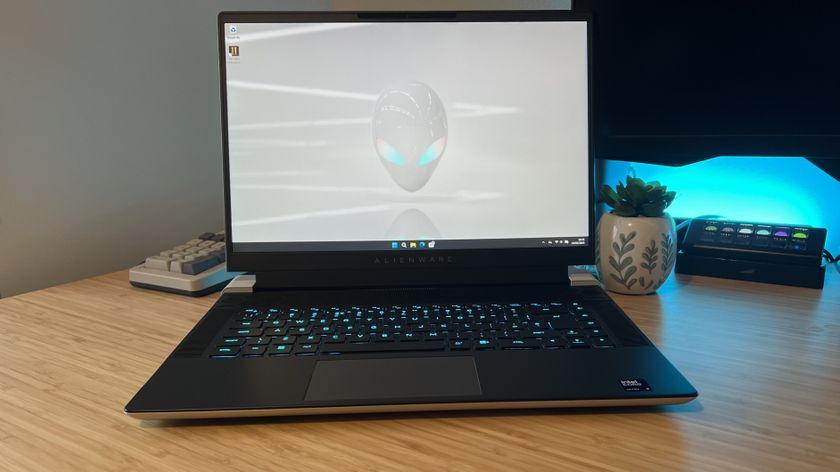
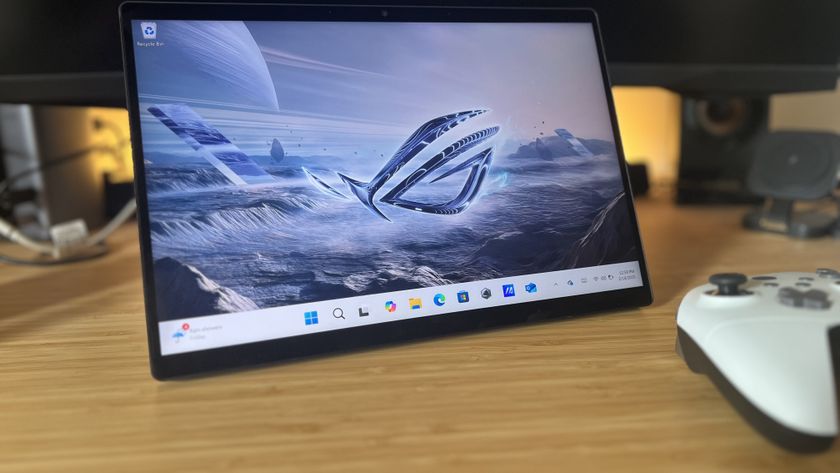
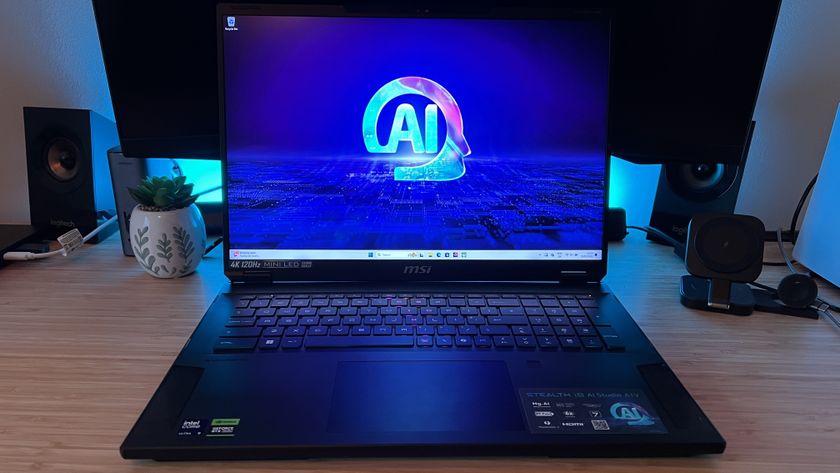
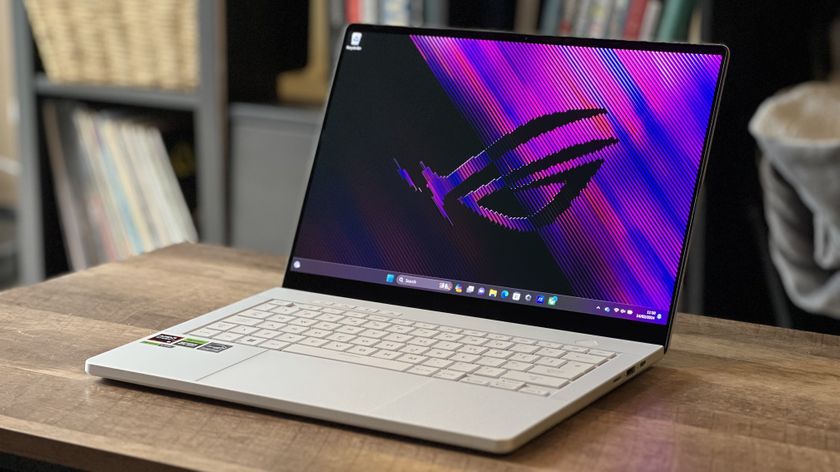
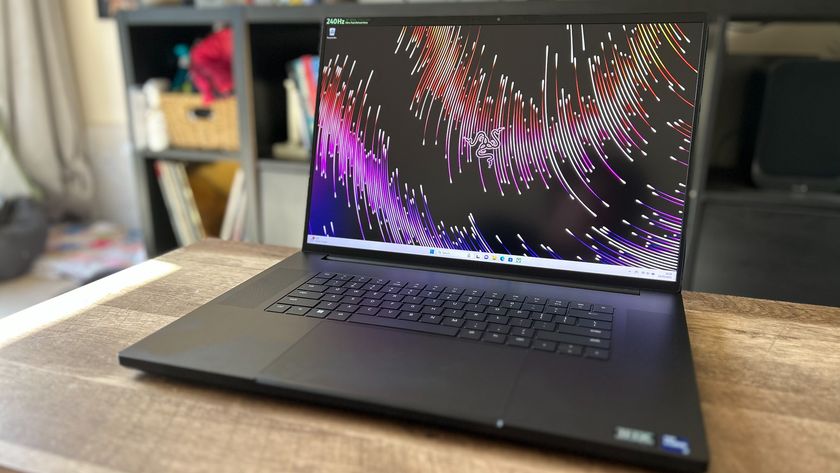
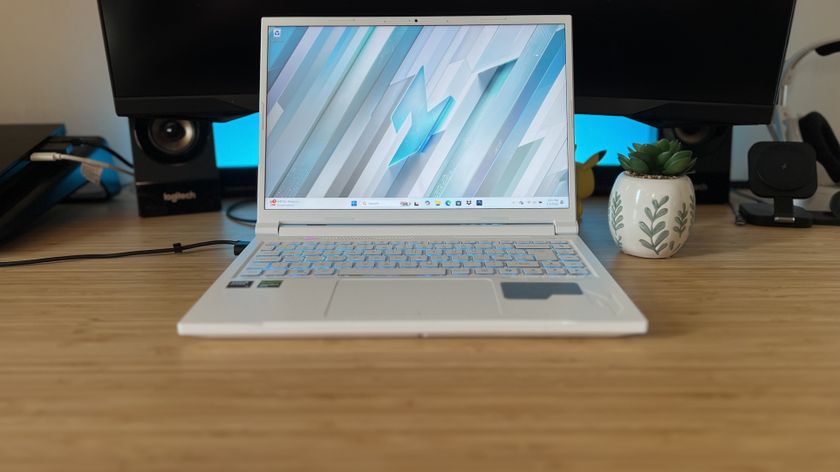
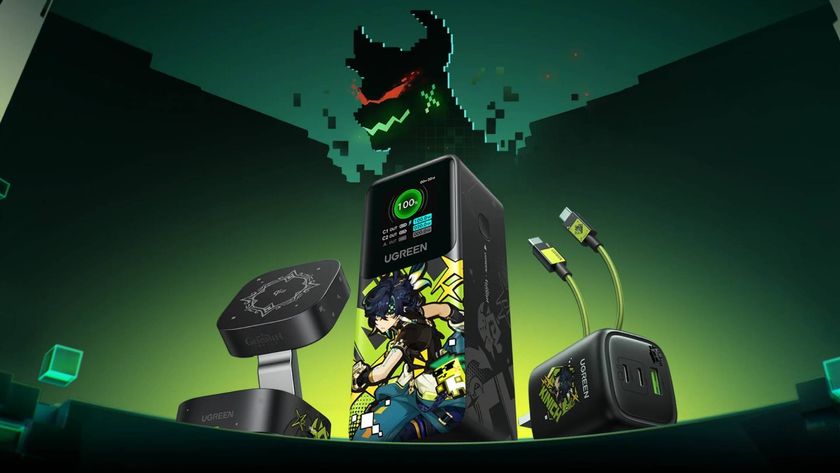

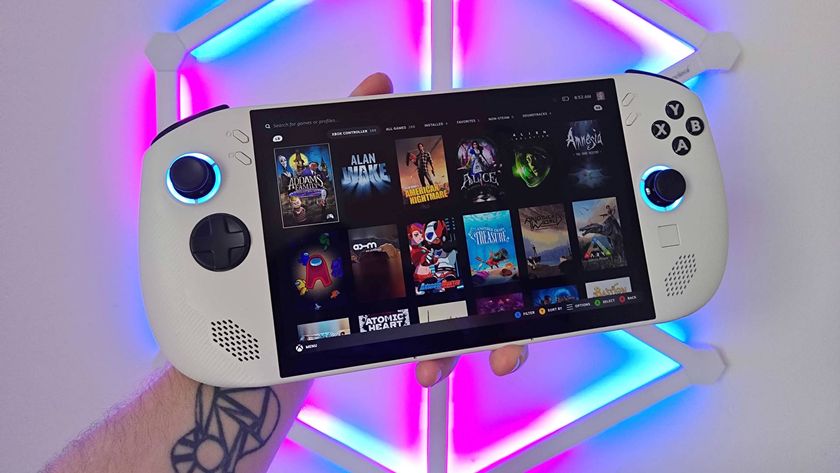
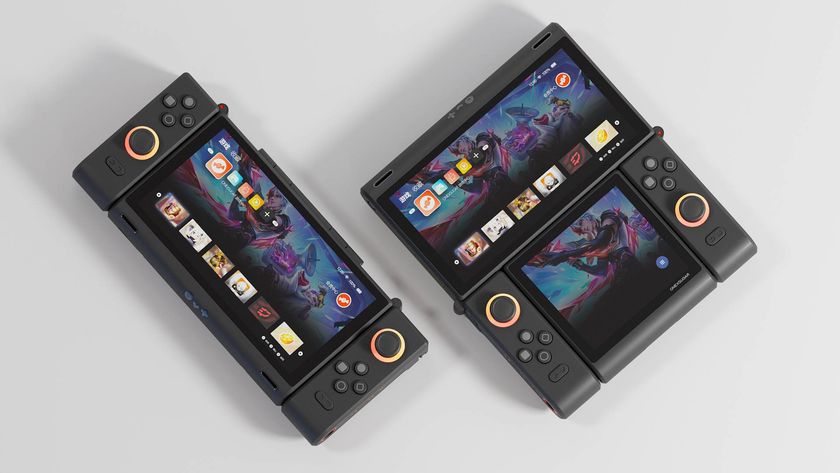
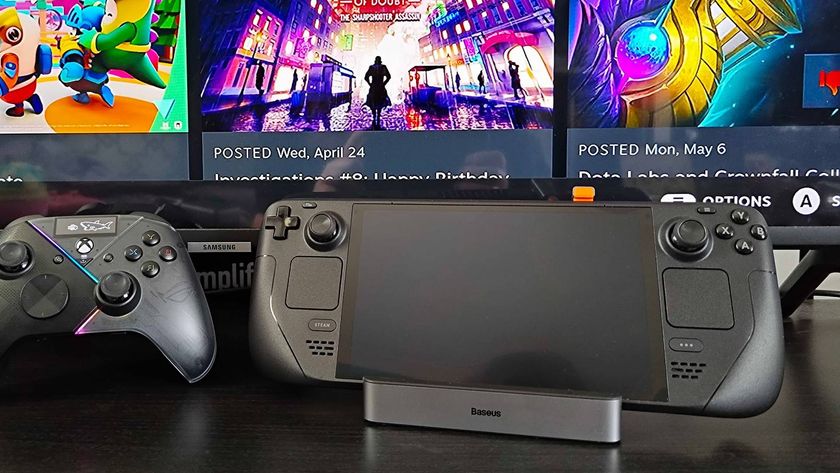
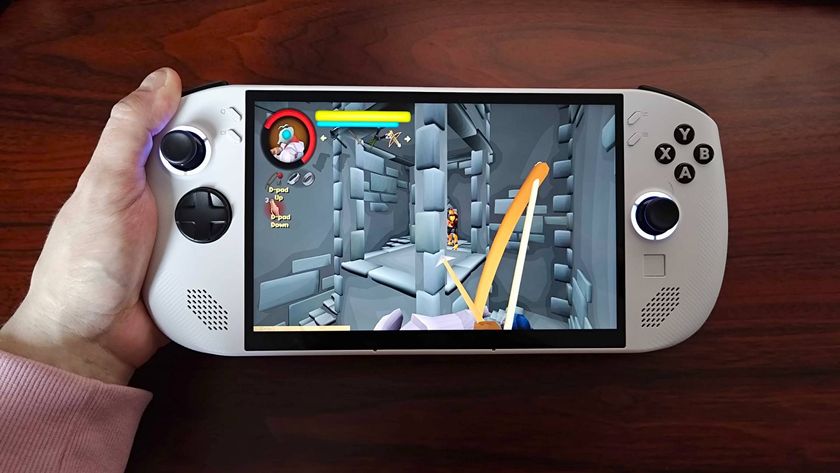







The Gritty Pac-Man reboot from Amazon's Secret Level, Shadow Labyrinth, has a launch date and some very dark gameplay

It took me over 20 hours to unlock Yasuke in Assassin's Creed Shadows, and a Kofun turned out to be the perfect training ground

Why rural British is the perfect setting for Atomfall’s unique approach to survival horror
